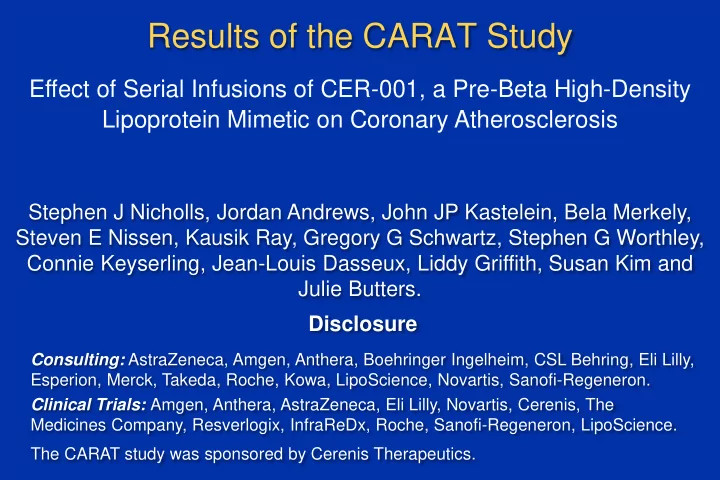

Results of the CARAT Study Effect of Serial Infusions of CER-001, a Pre-Beta High-Density Lipoprotein Mimetic on Coronary Atherosclerosis Stephen J Nicholls, Jordan Andrews, John JP Kastelein, Bela Merkely, Steven E Nissen, Kausik Ray, Gregory G Schwartz, Stephen G Worthley, Connie Keyserling, Jean-Louis Dasseux, Liddy Griffith, Susan Kim and Julie Butters. Disclosure Consulting: AstraZeneca, Amgen, Anthera, Boehringer Ingelheim, CSL Behring, Eli Lilly, Esperion, Merck, Takeda, Roche, Kowa, LipoScience, Novartis, Sanofi-Regeneron. Clinical Trials: Amgen, Anthera, AstraZeneca, Eli Lilly, Novartis, Cerenis, The Medicines Company, Resverlogix, InfraReDx, Roche, Sanofi-Regeneron, LipoScience. The CARAT study was sponsored by Cerenis Therapeutics.
Background • Epidemiological studies suggest that high-density lipoproteins (HDL) protect against cardiovascular disease. • However, HDL-cholesterol raising agents have not proven to reduce cardiovascular events in recent clinical trials. • CER-001 is a negatively charged, engineered pre-beta HDL mimetic containing apoA-I and sphingomyelin with favorable effects on measures of lipid transport. • Early studies demonstrated potential coronary plaque regression infusing low dose CER-001 in high plaque burden ACS patients and on carotid plaque in genetic dyslipidemia.
Objective of Study To perform a proof of concept study to determine whether ten infusions of a negatively charged HDL mimetic containing ApoA-I and sphingoymelin (CER-001) at a dose of 3 mg/kg would provide a signal suggesting an impact on coronary atherosclerosis in patients with a recent acute coronary syndrome and higher plaque burden.
Trial Leadership Stephen J. Nicholls MBBS PhD Study Chair Executive Committee John Kastelein MD PhD (Netherlands) Bela Merkely MD (Hungary) Steven E Nissen MD (USA) Kausik Ray MBBS PhD (UK) Gregory G Schwartz MD (USA) Stephen G Worthley MBBS PhD (Australia) Jean-Louis Dasseux (France)* * Sponsor representative
724 patients screened at 33 global centers with an acute coronary syndrome. Baseline percent atheroma volume >30% in proximal 10-mm in a target vessel. Intravascular ultrasound via motorized pullback at 0.5 mm/sec through >40 mm segment 301 patients underwent randomization stratified by country Standard of care Standard of care 9 weeks plus placebo (n=150) plus CER-001 (n=151) treatment 13 patients did not complete 16 patients did not complete 137 placebo completers 135 CER-001 completers Follow-up IVUS of originally imaged “ target ” vessel (n=272)
Baseline Demographics and Statin Usage Characteristic Placebo (N=137) CER-001 (n=135) P value Age 59.1 60.6 0.18 Male Gender 82.5% 77.0% 0.26 BMI kg/m 2 29.3 28.4 0.04 Hypertension 68.6% 64.4% 0.47 Diabetes 23.4% 15.6% 0.10 Smoking 34.3% 38.5% 0.47 Baseline statin use 28.5% 28.1% 0.95 Baseline LDL-C 81.2 mg/dL 85.1 mg/dL 0.07 Baseline HDL-C 38.7 mg/dL 38.7 mg/dL 0.61
Percent Change in Biochemical Parameters Characteristic Placebo CER-001 P Value LDL cholesterol -6.4% -7.0% 0.75 HDL cholesterol +5.4% +7.1% 0.72 Triglycerides +5.7% -1.9% 0.81 Apolipoprotein B -2.0% -5.1% 0.62 Apolipoprotein A-I +7.7% -4.0% 0.69 hsCRP -56.6% -60.0% 0.98 HDL: high-density lipoprotein; hsCRP: high-sensitivity C-reactive protein; LDL: low-density lipoprotein
Primary Endpoint: Percent Atheroma Volume 0 P =0.15 -0.09 (-1.8, 0.5) P=0.67 Median Change -0.41 (-1.6, 0.8) in Percent -0.5 P=0.01 Atheroma Volume (%) -1 Placebo CER-001 Results expressed as median (interquartile range)
Change in Total Atheroma Volume Entire Vessel Length Most Diseased 10-mm Segment 0 0 -1 Median Change Volume (mm 3 ) P = 0.64 P = 0.51 Median Change Volume (mm 3 ) -2 -2 -4 -3 -3.0 (-6.9, 1.5) P <0.001 -6 -5.6 (-12.4, 1.7) -3.5 (-7.7, 1.8) -4 P <0.001 P <0.001 -6.6 (-13.7, 1.7) P <0.001 -8 -5 Placebo CER-001 Placebo CER-001 Results expressed as median (interquartile range)
Percent of Patients Showing Regression PAV TAV 100% 100% P = 0.49 for comparison P = 0.50 for comparison to placebo group to placebo group 80% 80% Percentage of Patients (%) Percentage of Patients (%) 70.8% 67.4% 57.7% 60% 60% 53.3% 40% 40% 20% 20% 0% 0% Placebo CER-001 Placebo CER-001
Subgroup Analysis Subgroup Placebo CER-001 P Value -0.41 -0.11 0.29 <59 years Age -0.38 -0.04 0.63 >59 years -0.46 -0.03 0.16 Males Gender +0.27 -0.23 0.99 Females -0.92 -0.02 0.12 Diabetes Diabetes -0.37 -0.11 0.44 No diabetes -0.70 -0.70 0.83 <70 mg/dL -0.43 -0.09 0.26 LDL-C 70-100 mg/dL -0.03 +0.20 0.52 >100 mg/dL +0.02 -0.06 0.77 <38.1% PAV -0.86 -0.09 0.04 >38.1% -0.41 0.08 0.045 No Prior statin -0.41 -0.37 0.43 Yes
Adverse Clinical Events and Safety Findings Placebo CER-001 Event P Value (N=146) (n=147) ALT/AST >2x ULN 4.8% 4.1% 0.77 Total Bilirubin >2x ULN 0.7% 0.7% 0.99 CK >5x ULN 3.4% 0.7% 0.10 Serious adverse events 8.9% 8.2% 0.82 Allergic and infusion reactions 6.8% 8.2% 0.67 ALT: alanine transaminase; AST: aspartate transaminase; CK: creatine kinase; ULN: upper limit of normal
Conclusions • Short term treatment with CER-001 3 mg/kg did not produce a significant effect on coronary disease progression measured by IVUS. • Ten infusions of CER-001 were well tolerated. • These results occurred on a background of contemporary therapy in the post ACS setting. • Whether CER-001 impacts other settings remains to be determined.
Some Final Thoughts • Early imaging studies demonstrated favorable effects of HDL infusions on coronary atherosclerosis. • This provided support for development of HDL targeted agents as potential anti-atherosclerotic therapies • However, the lack of benefit with short term therapy with CER-001 3 mg/kg in CARAT suggests that this is not a promising strategy for ACS patients. • Whether HDL therapy can impact plaque or clinical events in the setting of contemporary therapy remains to be determined, although with each disappointing study result the considerable challenge remains.
Recommend
More recommend